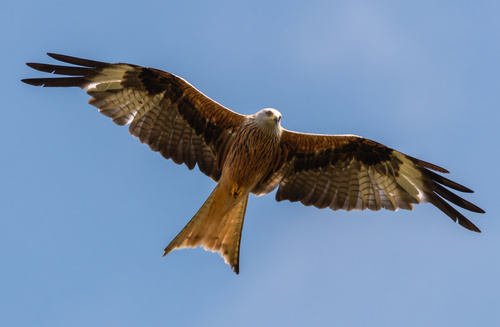
Red Kite
The Red Kite (Milvus milvus) is a medium-large bird of prey renowned for its graceful flight and distinctive forked tail. Once driven to near extinction in many parts of Europe, it has made a remarkable comeback in some regions thanks to dedicated conservation efforts. Ecologically, it plays a vital role as both a predator and scavenger, helping to regulate populations of small mammals and remove carrion from the landscape. The Red Kite holds a place in folklore and has historically been both persecuted and admired.
60-70 cm
Length
175-195 cm
Wingspan
Near Threatened
Conservation Status
Distribution
The Red Kite is primarily found in Europe, with strongholds in Spain, France, Germany, and the United Kingdom. Smaller populations exist in North Africa and the Middle East. Some populations are migratory, moving south for the winter, while others are resident year-round. Their altitudinal range extends from sea level to mountainous regions, up to around 2,000 meters.
Lifespan
The typical lifespan in the wild is around 10 years, but individuals can live up to 25 years or more in captivity.
Red Kite's Habitat
Habitat Types
Open woodlands, Farmland, Grasslands, Pastures, Uplands
Climate Zones
Temperate, Mediterranean
Adaptations
Red Kites show a preference for mosaic landscapes providing both open areas for hunting and wooded areas for nesting and roosting. They are adaptable and can tolerate a degree of human presence, often nesting near villages and farms.
Variations
Two subspecies are generally recognized: *Milvus milvus milvus* (Europe and northwest Africa) and *Milvus milvus fasciicauda* (Cape Verde Islands). The Cape Verde Kite is critically endangered and may even be extinct.
Appearance
Breeding Plumage
Plumage is generally similar year-round, but may be slightly brighter during the breeding season.
Seasonal Feather Changes
Minor seasonal variations, with fresher plumage after molting.
Sex Based Plumage Differences
Minimal sexual dimorphism in plumage, although females may appear slightly duller.
Notable Features
Deeply forked tail, reddish-brown in color., Reddish-brown body plumage with dark streaks., Pale grey head with dark streaking., Long, angled wings with distinctive white patches.
Diet and Feeding
Primary Foods
Small mammals (voles, mice, rabbits), Carrion, Birds, Earthworms, Insects
Foraging Behavior
Red Kites are opportunistic feeders, soaring and gliding over open areas to search for prey. They also scavenge for carrion, often seen feeding on roadkill. They are known to steal food from other birds (kleptoparasitism).
Specializations
Their keen eyesight allows them to spot prey from a considerable height. Their forked tail provides exceptional maneuverability during flight, aiding in hunting and scavenging.
Seasonal Diet Variations
Diet can vary seasonally depending on prey availability. Carrion may be more important in winter when live prey is scarce. Earthworms can be a significant food source during wet periods.
Behavior
Social Structure
Red Kites are generally solitary or found in pairs during the breeding season. Outside of the breeding season, they may form communal roosts, sometimes numbering hundreds of birds.
Communication
Whistling calls, often described as a 'kee-kee-kee' sound., Mewing calls., Visual displays, including aerial acrobatics.
Migration
Some populations, particularly those in northern and eastern Europe, are migratory, traveling south to wintering grounds in southern Europe and Africa. Other populations, such as those in the UK, are largely resident.
Territorial or Group Behaviors
During the breeding season, Red Kites defend a territory around their nest. Outside of the breeding season, they are more tolerant of other individuals and often congregate at roosting sites and abundant food sources.
Conservation
Threats
Poisoning (both intentional and accidental), Habitat loss and degradation, Collision with power lines and wind turbines, Reduced food availability (due to changes in farming practices)
Protection Programs
Reintroduction programs (successful in the UK), Legal protection in many countries, Habitat restoration and management, Monitoring and research
Local National Laws
Protected under various national and international laws, including the EU Birds Directive.
Population Trend
Increasing in many parts of its range, following significant declines in the past.
Population Estimates
The global population is estimated to be between 129,000-198,000 mature individuals.
Interesting Facts
Red Kites often decorate their nests with unusual objects.
They are known to collect items such as plastic bags, paper, and even clothing, incorporating them into the nest structure.
They are highly agile fliers.
Their deeply forked tail allows for exceptional maneuverability, enabling them to make tight turns and dives.
Red Kites were once common in London.
In medieval times, they were valued as scavengers, helping to keep the streets clean. They were protected by law, and killing a Red Kite was a serious offense.
Faqs about Red Kite
Are Red Kites dangerous to humans?
No, Red Kites are not dangerous to humans. They are shy birds and generally avoid close contact with people.
What should I do if I find an injured Red Kite?
Do not attempt to handle the bird yourself. Contact a local wildlife rescue organization or veterinarian for assistance. *Consult a professional for expert advice.*
Do Red Kites mate for life?
Red Kites are generally monogamous and often form long-term pair bonds, although 'divorce' can occur.
Copyright @ Nature Style Limited. All Rights Reserved.
 English
English